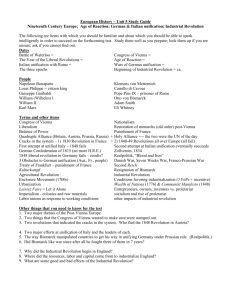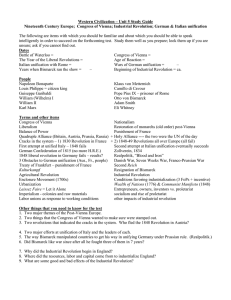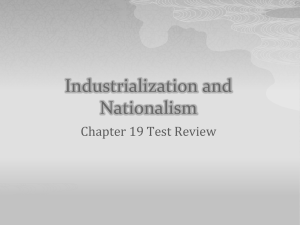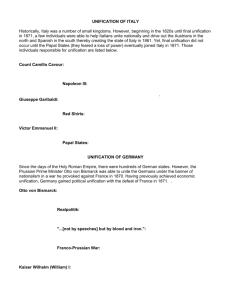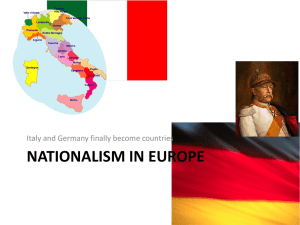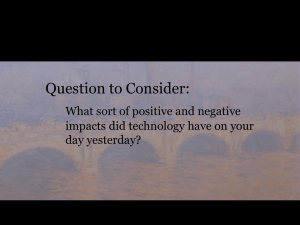Chapter 12, Section 1 The Industrial Revolution
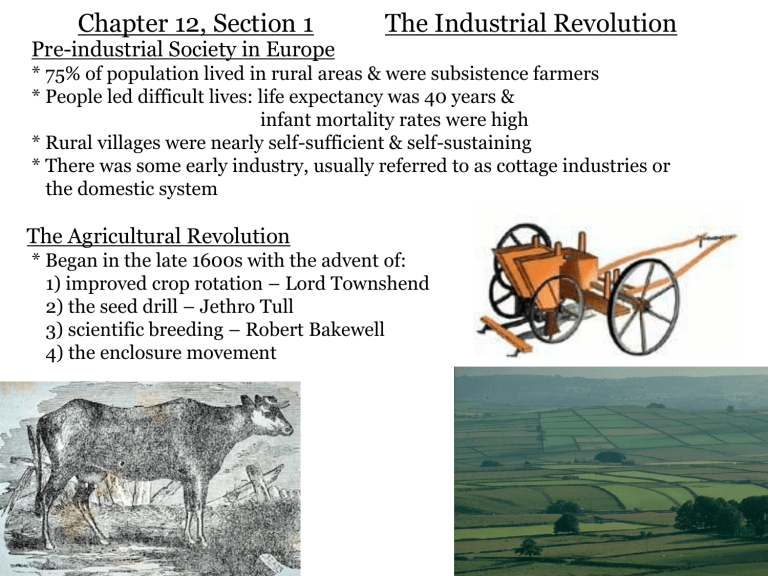
Chapter 12, Section 1
Pre-industrial Society in Europe
The Industrial Revolution
* 75% of population lived in rural areas & were subsistence farmers
* People led difficult lives: life expectancy was 40 years & infant mortality rates were high
* Rural villages were nearly self-sufficient & self-sustaining
* There was some early industry, usually referred to as cottage industries or the domestic system
The Agricultural Revolution
* Began in the late 1600s with the advent of:
1) improved crop rotation – Lord Townshend
2) the seed drill – Jethro Tull
3) scientific breeding – Robert Bakewell
4) the enclosure movement
Britain Leads the Way
* Britain was the first nation to bring together the factors of production needed for industrialization:
1) land – natural resources
2) labor – workers
3) capital – money for investment
4) technology – inventions and innovation
* Britain’s industrial revolution was led by the cotton textile industry:
1) flying shuttle (1733) – John Kay
2) spinning jenny – James Hargreaves
3) water frame – Richard Arkwright
4) spinning mule – Samuel Crompton
5) power loom – Edmund Cartwright
6) cotton gin (1793) – Eli Whitney
* An energy revolution helped trigger the Industrial Revolution by providing new sources of power:
1) windmills
2) water wheels
3) steam engine – Thomas Newcomen (1712) & James Watt (1769)
* Other improvements that helped industrial development:
1) Iron & Coal a) Abraham Darby & Henry Cort
- iron-making using coal b) Abraham Darby III
- world’s first cast iron bridge
2) Transportation a) paved roads – turnpikes b) railroads; steam-powered locomotives c) canals & improved harbors d) steamboats, steamships
- Robert Fulton
* The social change brought about by the Industrial Revolution was evident by the emergence of the middle class & the working class.
Chapter 12, Section 2 Reaction and Revolution
* After suffering defeat, Napoleon was removed from power.
European leaders met at the Congress of Vienna in 1815 to restore peace & redraw the map of Europe.
* The Congress of Vienna sought to re-impose the “old order” in Europe & created the Concert of Europe to maintain peace throughout Europe.
* After the Congress of Vienna, challenges from groups with opposing viewpoints led to a clash of ideologies:
1) conservatism – belief in tradition & social stability; supported pre-revolutionary political & social order; wanted to restore monarchies in Europe
2) liberalism – belief that people should be free from government restraint; embraced
Enlightenment ideas; wanted government based on written constitutions & separation of powers
3) nationalism – wanted to unify & gain independence for people with a common national heritage
* Conservative forces weakened liberalism & nationalism for the short term, but could not destroy them for good
* Social & political discontent sparked revolutions in France in 1830 & 1848, which in turn inspired revolts in other parts of Europe.
Chapter 12, Section 3 National Unification & the National State
Unifying Italy
* Series of events during 19th century led to unification of Italy:
1) 1831, Giuseppe Mazzini founded Young Italy
2) 1848, Victor Emmanuel II, king of Sardinia, began leading unification movement
3) 1852, Victor Emmanuel II appointed Camillo Cavour as prime minister
4) 1858, Cavour formed alliance with France against Austria
5) 1860, Giuseppe Garibaldi formed the Red Shirts & led unification movement in southern Italy
6) 1861, Victor Emmanuel II became king of constitutional monarchy of Italy
7) 1870, Italy took Rome & moved the capital from Florence to Rome
Building a German Nation
* Otto von Bismarck, the chancellor of Prussia, led the drive for German unification
* Series of events during 19 th century led to German unification:
1) 1815, German Confederation created at Congress of Vienna
2) 1834, Zollverein (economic union) formed
3) 1861, William I became king of Prussia
4) 1862, Bismarck appointed chancellor of Prussia
5) Bismarck involved Prussia in 3 wars to achieve
German unification: a) Danish War – 1864 b) Austro-Prussian War – 1866 c) Franco-Prussian War – 1870
6) Jan. 1871, William I became kaiser of new German empire
Nationalism & Reform in Europe & North America
* In Austria, the Compromise of 1867 created the dual monarchy of Austria-Hungary.
* In Russia, Czar Alexander II freed the serfs by issuing the
emancipation edict in 1861.
* In North America, the British North America Act established Canada as a self-governing nation in 1867.
* In the U.S., slavery was becoming a major threat to American national unity during the 19 th century.
Chapter 12, Section 4 Culture: Romanticism and Realism
* At the end of the 18 th century, romanticism emerged as a reaction to the ideas of the
Enlightenment.
* Romanticism emphasized human emotion & imagination over reason. Through music, literature, and painting, romantic artists attempted to stir the emotions.
* Eugene Delacroix was the most famous romantic painter in France.
* Ludwig van Beethoven was one of the greatest composers of all time. Beethoven was the bridge between the classical and romantic periods in music.
* By the mid-1800s, realism became a movement in the arts. Literary realists rejected romanticism.
* British novelist Charles Dickens wrote realistic novels focusing on the lower & middle classes in Britain.
A New Age of Science
* The Industrial Revolution created a new interest in science & helped produce the realist movement.
* By the 1830s science had made discoveries that benefited all Europeans:
1) Louis Pasteur proposed the germ theory of disease.
2) Mendeleyev classified all the known material elements by their atomic weights.
3) Michael Faraday was laying the foundation for the use of electric current.
* 1859, Charles Darwin published On the Origin of Species by Means of Natural
Selection. Darwin proposed that natural selection was central to organic evolution.
Darwin also wrote another controversial work titled The Descent of Man.
